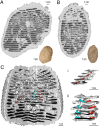Self-organized biotectonics of termite nests
- PMID: 33468628
- PMCID: PMC7865135
- DOI: 10.1073/pnas.2006985118
Self-organized biotectonics of termite nests
Abstract
The termite nest is one of the architectural wonders of the living world, built by the collective action of workers in a colony. Each nest has several characteristic structural motifs that allow for efficient ventilation, cooling, and traversal. We use tomography to quantify the nest architecture of the African termite Apicotermes lamani, consisting of regularly spaced floors connected by scattered linear and helicoidal ramps. To understand how these elaborate structures are built and arranged, we formulate a minimal model for the spatiotemporal evolution of three hydrodynamic fields-mud, termites, and pheromones-linking environmental physics to collective building behavior using simple local rules based on experimental observations. We find that floors and ramps emerge as solutions of the governing equations, with statistics consistent with observations of A. lamani nests. Our study demonstrates how a local self-reinforcing biotectonic scheme is capable of generating an architecture that is simultaneously adaptable and functional, and likely to be relevant for a range of other animal-built structures.
Keywords: collective animal behavior; ecophysiology; morphogenesis; stigmergy; termite nests.
Conflict of interest statement
The authors declare no competing interest.
Figures




References
-
- Hansell M., Animal Architecture (Oxford University Press, 2005).
-
- Perna A., Theraulaz G., When social behavior is molded in clay: On growth and form of social insect nests. J. Exp. Biol. 220, 83–91 (2017). - PubMed
-
- Lee C. C., Neoh K. B., Lee C. Y., Caste composition and mound size of the subterranean termite macrotermes gilvus (isoptera: Termitidae: Macrotermitinae). Ann. Entomol. Soc. Am. 105, 427–433 (2012).
-
- Turner J. S., On the mound of macrotermes michaelseni as an organ of respiratory gas exchange. Physiol. Biochem. Zool. 74, 798–822 (2001). - PubMed
Publication types
MeSH terms
LinkOut - more resources
Full Text Sources
Other Literature Sources

